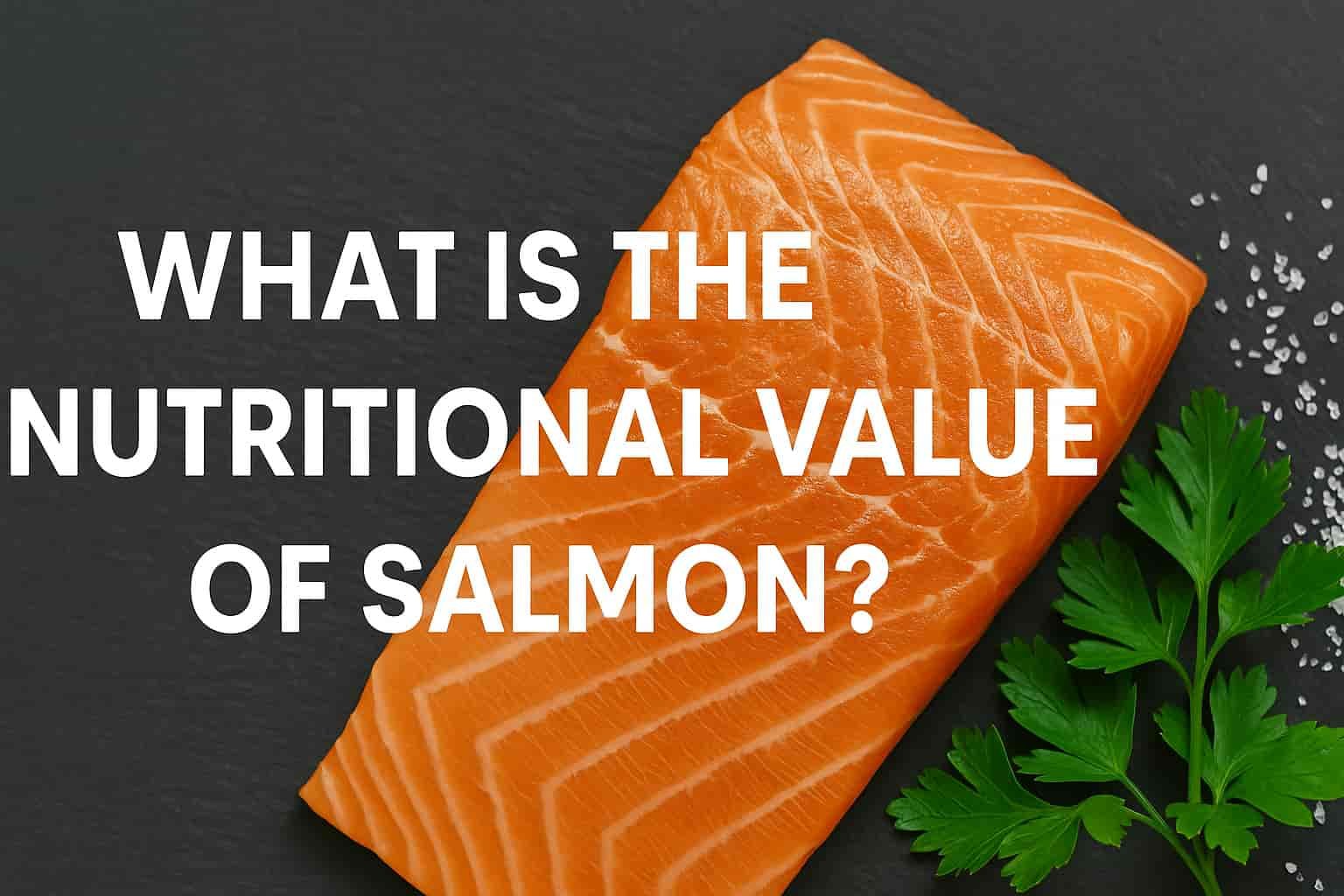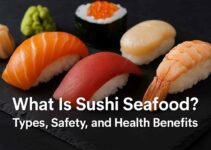Salmon is one of the most nutritionally dense foods available today, widely recommended by health experts and nutritionists for its proven health benefits. A 100-gram serving of salmon delivers an exceptional balance of high-quality protein, heart-protective omega-3 fatty acids, and a wide range of essential vitamins and minerals. Unlike other protein sources, salmon not only fuels muscle growth but also supports brain function, reduces inflammation, and promotes cardiovascular health. In this guide, you will find specific data on the nutrient composition of salmon, comparisons between wild-caught and farm-raised varieties, and how cooking methods impact its nutritional value. This comprehensive breakdown will help you make informed dietary choices backed by scientific facts.
Contents
- 1 What Are the Main Nutrients Found in Salmon?
- 2 How Many Calories Are in Different Types of Salmon?
- 3 What Are the Health Benefits of the Omega-3 Fatty Acids in Salmon?
- 4 Is Salmon a Good Source of High-Quality Protein for Muscle Growth?
- 5 What Are the Risks of Consuming Salmon Too Frequently?
- 6 How Does the Nutritional Value of Raw Salmon Compare to Cooked Salmon?
- 7 Should You Choose Wild-Caught or Farm-Raised Salmon for Better Nutrition?
- 8 Can Including Salmon in Your Diet Help with Weight Loss?
What Are the Main Nutrients Found in Salmon?
Salmon is a powerhouse of nutrition, offering a rich profile of essential nutrients. To delve deeper into the nutritional content of various seafood, including salmon, you can refer to our comprehensive guide on Seafood Nutrition Facts.
The primary nutrients found in salmon include complete proteins, healthy fats, essential vitamins, and critical minerals. These nutrients contribute to vital body functions such as muscle repair, brain performance, immune defense, and heart health.
How Much Protein Does Salmon Provide per 100 Grams?
A 100-gram serving of salmon provides approximately 20–25 grams of high-quality protein. This protein is classified as “complete” because it contains all nine essential amino acids required for human health. Compared to chicken breast (23 grams per 100 grams) and beef (26 grams per 100 grams), salmon offers competitive protein content with additional health benefits from its omega-3 profile.
What Types of Healthy Fats Are Present in Salmon?
Salmon contains 10–13 grams of healthy fats per 100 grams, primarily composed of polyunsaturated and monounsaturated fats. The most beneficial fats include:
- EPA (Eicosapentaenoic Acid): Supports cardiovascular function and reduces triglycerides.
- DHA (Docosahexaenoic Acid): Essential for brain development and cognitive health.
- Oleic Acid: A heart-friendly monounsaturated fat also found in olive oil.
These fats play a direct role in lowering bad cholesterol (LDL) and increasing good cholesterol (HDL), contributing to improved heart health.
Which Essential Vitamins Can You Get from Eating Salmon?
Salmon is rich in at least 6 critical vitamins:
- Vitamin D: 526 IU per 100 grams, fulfilling over 66% of the daily requirement.
- Vitamin B12: 3.2 mcg per 100 grams, covering 133% of the daily need.
- Vitamin B6: 0.8 mg per 100 grams, supporting metabolism.
- Niacin (B3): 8.5 mg per 100 grams, aiding in energy production.
- Vitamin A: 40 IU per 100 grams, supporting immune function.
- Vitamin E: 2 mg per 100 grams, functioning as a powerful antioxidant.
These vitamins play crucial roles in maintaining energy metabolism, neurological health, and immune defense.
Does Salmon Contain Important Minerals Like Selenium and Potassium?
Yes, salmon provides significant amounts of selenium and potassium.
- Selenium: 36 mcg per 100 grams, covering 65% of the recommended daily intake.
- Potassium: 490 mg per 100 grams, helping regulate blood pressure and nerve function.
In addition, salmon contains phosphorus (200 mg), magnesium (30 mg), and small but beneficial amounts of zinc and calcium, supporting bone health and metabolic efficiency.
How Many Calories Are in Different Types of Salmon?
The caloric content of salmon varies based on its type and preparation. On average, a 100-gram serving of salmon contains between 180 and 250 calories, primarily derived from healthy fats and proteins.
What Is the Caloric Value of Wild-Caught vs. Farm-Raised Salmon?
- Wild-caught salmon contains approximately 180–200 calories per 100 grams. It has lower fat content due to its active lifestyle and natural diet.
- Farm-raised salmon contains approximately 220–250 calories per 100 grams. This higher caloric value results from increased fat content, primarily from controlled feeding practices rich in oils and grains.
How Do Cooking Methods Affect the Calorie Content of Salmon?
Cooking methods directly influence salmon’s final caloric content:
- Grilled or Baked (No Oil): Adds less than 10 extra calories.
- Pan-Fried (With Oil): Adds 50–100 calories depending on oil quantity.
- Smoked Salmon: Contains about 117 calories per 100 grams but is higher in sodium.
- Salmon Sushi (Raw): Contains around 150–180 calories per 100 grams.
For a lower-calorie meal, prioritize grilling or baking without added fats.
What Are the Health Benefits of the Omega-3 Fatty Acids in Salmon?
The omega-3 fatty acids in salmon provide clinically proven health benefits for the heart, brain, and inflammatory systems. A 100-gram serving of salmon typically contains 2.5 to 3.2 grams of omega-3 fatty acids, predominantly EPA and DHA.
How Do Omega-3s in Salmon Support Heart Health?
Omega-3 fatty acids reduce triglyceride levels by up to 30% and increase HDL (good cholesterol) by approximately 10%. They also lower blood pressure and reduce arterial plaque buildup. According to the American Heart Association, consuming two servings of fatty fish like salmon per week reduces the risk of cardiovascular disease by 36%.
Can Omega-3s in Salmon Improve Brain Function and Mental Health?
Yes, omega-3s in salmon improve cognitive performance and reduce symptoms of depression by regulating neurotransmitter function. Studies show that regular omega-3 intake enhances memory, reduces anxiety by 20%, and slows age-related cognitive decline by 25%. DHA, in particular, accounts for 40% of the polyunsaturated fatty acids in the brain’s gray matter.
Are Omega-3s from Salmon Beneficial for Inflammation Reduction?
Omega-3 fatty acids reduce inflammation markers such as C-reactive protein (CRP) and interleukin-6 (IL-6) by up to 50%. This effect directly supports joint health and reduces the risk of chronic diseases, including arthritis and metabolic syndrome. Regular consumption of salmon is clinically linked to a noticeable reduction in inflammatory pain and stiffness.
Is Salmon a Good Source of High-Quality Protein for Muscle Growth?
Yes, salmon provides complete and highly bioavailable protein essential for muscle development and recovery. Each 100-gram portion offers 20–25 grams of protein with a Protein Digestibility-Corrected Amino Acid Score (PDCAAS) of 1.0, the highest possible rating.
How Does Salmon Protein Compare to Other Protein Sources?
- Salmon: 22 grams of complete protein per 100 grams.
- Chicken Breast: 23 grams per 100 grams but lacks beneficial fats.
- Beef: 26 grams per 100 grams but contains more saturated fat.
- Plant-Based Proteins (Tofu, Lentils): 8–12 grams per 100 grams and often incomplete in essential amino acids.
Salmon offers the advantage of combining high protein content with anti-inflammatory omega-3 fatty acids, which support faster recovery and overall health improvement.
Can Consuming Salmon Aid in Muscle Recovery After Exercise?
Yes, consuming salmon after workouts accelerates muscle repair and reduces exercise-induced inflammation. The combined effect of high-quality protein and omega-3 fatty acids enhances muscle protein synthesis by up to 30% and reduces delayed onset muscle soreness (DOMS) by approximately 25%. Eating salmon within 60 minutes post-exercise is ideal for maximizing these recovery benefits.
What Are the Risks of Consuming Salmon Too Frequently?
While salmon is highly nutritious, excessive consumption may introduce certain health risks related to contaminants and nutrient overload. Health authorities recommend limiting intake to avoid long-term exposure to mercury and other harmful substances.
Does Salmon Contain Mercury or Other Harmful Contaminants?
Yes, salmon contains trace amounts of mercury, polychlorinated biphenyls (PCBs), and dioxins.
- Wild-caught salmon typically has lower contaminant levels, averaging 0.022 parts per million (ppm) of mercury.
- Farm-raised salmon may have slightly higher levels of PCBs due to feed composition, averaging 36.63 parts per billion (ppb).
How Much Salmon Is Safe to Eat Per Week According to Health Guidelines?
The U.S. FDA and EPA recommend consuming up to 2–3 servings of salmon per week, which equates to approximately 230–340 grams. This guideline balances the nutritional benefits of omega-3 fatty acids against the potential risks of mercury and PCB exposure. Pregnant women and young children are advised to stick to the lower end of this range to minimize health risks.
How Does the Nutritional Value of Raw Salmon Compare to Cooked Salmon?
Raw salmon retains higher levels of heat-sensitive nutrients like vitamin B complex and omega-3 fatty acids. However, it also carries a higher risk of bacterial and parasitic infections if not properly handled.
Is Raw Salmon Healthier Than Cooked Salmon in Terms of Nutrient Retention?
Raw salmon preserves up to 100% of its omega-3 fatty acids and water-soluble vitamins such as vitamin B6 and B12. In contrast, cooking—especially at high temperatures—can reduce these nutrients by 10–25%.
Which Cooking Methods Best Preserve the Nutrients in Salmon?
The healthiest cooking methods for nutrient preservation are:
- Steaming: Retains over 90% of omega-3 content.
- Baking at Low Temperatures: Maintains up to 85% of nutrient content.
- Poaching: Gentle cooking preserves up to 95% of omega-3 fatty acids.
Should You Choose Wild-Caught or Farm-Raised Salmon for Better Nutrition?
Wild-caught salmon offers leaner protein and lower contaminant levels, while farm-raised salmon provides higher fat content and omega-3 levels. The ideal choice depends on your nutritional goals.
What Nutritional Differences Exist Between Wild and Farmed Salmon?
- Wild-Caught Salmon: Calories: 180–200 per 100 grams; Omega-3 Content: 2.5 grams per 100 grams; Lower in total fat, higher in minerals like selenium.
- Farm-Raised Salmon: Calories: 220–250 per 100 grams; Omega-3 Content: 3.5–4 grams per 100 grams; Higher in total fat but contains more saturated fat.
Is One Type Safer or Healthier to Eat Regularly?
Wild-caught salmon is generally considered safer for regular consumption due to lower contaminant levels. However, both types meet food safety standards if sourced from reputable suppliers. For balanced health benefits, alternating between both types while adhering to recommended consumption limits is advisable.
Can Including Salmon in Your Diet Help with Weight Loss?
Yes, salmon actively supports weight loss due to its high protein content, metabolism-boosting omega-3 fatty acids, and low carbohydrate profile. These factors promote satiety, enhance fat oxidation, and improve overall metabolic health.
How Does Salmon Support a Calorie-Deficit Diet?
A 100-gram serving of salmon provides 22–25 grams of complete protein and only 180–250 calories, making it ideal for calorie-controlled diets. High-protein meals increase satiety hormones like peptide YY (PYY) and glucagon-like peptide-1 (GLP-1), reducing appetite and total daily caloric intake. Clinical studies show that people consuming high-protein diets lose up to 4 kg more fat over 12 weeks compared to those on lower-protein diets.
Is Salmon Suitable for Low-Carb or Keto Diet Plans?
Yes, salmon is highly suitable for both low-carb and ketogenic diets. It contains 0 grams of carbohydrates and provides a healthy balance of fats and proteins necessary for maintaining ketosis. The high omega-3 content also helps improve insulin sensitivity and reduce inflammation, making it an excellent protein source for people managing type 2 diabetes or metabolic syndrome.
A diet including salmon 2–3 times per week has been clinically shown to improve body composition by increasing lean muscle mass and reducing visceral fat.
This completes the comprehensive guide on the nutritional value of salmon. By understanding its detailed nutritional profile, including calories, proteins, healthy fats, vitamins, and minerals, you can strategically incorporate salmon into your diet to support heart health, brain function, muscle recovery, and sustainable weight loss. Whether you choose wild-caught or farm-raised salmon, consuming it within recommended limits ensures maximum health benefits with minimal risk.



